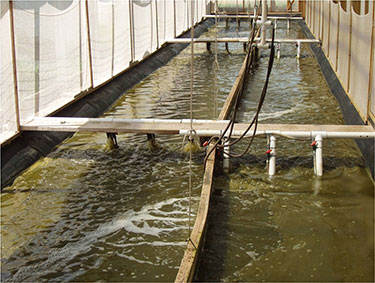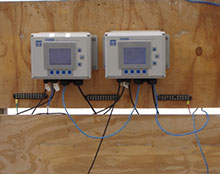Dissolved Oxygen Monitoring Improves Raceway Shrimp Production
The use of limited discharge recirculating aquaculture systems can reduce disease introduction and the potential negative environmental impact created by traditional pond culture where extensive water exchanges are being utilized. 
In recent years, studies at the Texas A&M AgriLife Research Mariculture Lab at Flour Bluff have focused on the use of a specially designed diet made by Zeigler Bros, Gardners, PA (HI-35) formulated for use in biofloc dominated super-intensive zero-exchange systems. In addition, the use of continuous online dissolved oxygen monitoring and control systems by the YSI 5500D continuous multiDO monitor has been utilized.
Culture systems are characterized by high stocking densities (>300 shrimp/m3) and high yields (>3-6 kg/m3). An earlier study at the lab showed that high yields (9.58 kg/m3) and good survival (81.6%) can be achieved with no water exchange under stocking density of 500 shrimp/m3 while using foam fractionators and settling tanks to regulate levels of particulate matter in the culture medium.
Study Objectives
- Study the effect of two commercial diets on shrimp performance and selected water quality indicators under zero water exchange.
- Monitor shrimp growth, survival, and FCR (feed conversion ratios) under zero water exchange.
- Produce market-size L. vannamei at a high stocking density with zero water exchange.
- Evaluate the benefit of using the YSI 5500D continuous DO monitoring system in operating a super-intensive shrimp production system.
The study was conducted in six 40 m3/68.5 m2 raceways (RWs). Each 25.4 m x 2.7 m RW lined with EPDM (Firestone Specialty Products, Indianapolis, IN). RWs were equipped with a center longitudinal partition positioned over a 5.1 cm PVC pipe with sprayer nozzles. Each RW had six banks of three 5.1 cm airlift pumps positioned equidistance on both sides of the partition. In addition, each RW had six 0.91 cm long air diffusers (1.9 cm OD, Aero- TubeTM, Tekni-plex Aeration, Austin, TX), a 2 HP centrifugal pump, and a Venturi injector capable of introducing atmospheric air or a mixture of oxygen and air.
RWs were filled with a mixture of water used in a preceding 49-d nursery study, seawater, and municipal freshwater to reach a salinity of 30 ppt. Each RW was equipped with a small commercial foam fractionator (FF) (VL65) and a homemade settling tank (ST). Shrimp used in this study was produced from a cross between Taura resistant and fast-growth genetic lines developed by Shrimp Improvement Systems (Islamorada, FL). RWs were stocked with juvenile (2.66 g) shrimp at a density of 500 shrimp/m3.
Comparison
The study compared two feeds with three replicates each; a semi-intensive diet (SI-35) which had 35% CP, 7% lipid, and 4% fiber, and a hyper-intensive diet (HI-35) with 35% CP, 7% lipid, and only 2% fiber. Three RWs were designated for the HI treatment and three were designated as SI treatment. Shrimp were fed by hand and automatic belt-feeders for the first 11 days. From Day 12 until the end of the study feed was delivered by belt-feeders.
For the first month, daily rations were based on an assumed growth of 1.5 g/wk, FCR of 1.4, and mortality rate of 0.5%/ wk. Rations were later adjusted based on observed feed consumption and shrimp growth rates which were adjusted up to 2.56 g/wk. Use of the FFs and the STs was initiated 7 and 44 days from the study initiation, respectively.
These particulate matter control devices were operated intermittently, targeting culture water TSS concentrations between 200 and 400 mg/L and settleable solids between 10 and 12 mL/L. RWs were maintained with zero water exchange throughout the study and municipal chlorinated freshwater was added to compensate for water losses due to evaporation and operation of the FFs and STs.
Water temperature, salinity, dissolved oxygen, and pH were monitored twice daily using a YSI 6-series multiparameter sonde (6920V2 or EXO). Settleable solids were monitored daily. Alkalinity was measured twice a week; TSS was monitored three times a week, while turbidity, VSS, cBOD5, TAN, NO2, NO3, and PO4-P were monitored weekly.
Each RW was equipped with YSI 5500D multiDO monitoring and alarm system with optical DO probes. Data collected by the monitoring system was uploaded into a computer in the lab which could also be accessed from remote locations for real-time monitoring of the DO in the six RWs. Daily and weekly water quality data from the two treatments was analyzed by Linear Mixed Models, using Factor Analytic (First Order, Heterogeneous).
Shrimp mean final weights, weekly growth rate, survival (arcsine transformed), FCR, and total yields were analyzed using one-way ANOVA. A significance level of p<0.05 was used for all statistical tests. Oxygen supplementation was initiated on Day 17 and continued until the end of the 67 day study. From Day 17 until Day 38 supplementation was related to daily events (e.g., feeding, molasses addition).
Beginning Day 39, when shrimp biomass was estimated to be 6 kg/m3, supplemental oxygen was used 24 hr/day at a flow rate of 3.4–8.2 LPM due to low DO in the RWs. The YSI 5500D monitors and their optical probes proved to be a valuable tool for the management of super-intensive shrimp culture, allowing quick adjustments to be made to minimize stress from low DO while setting upper and lower DO limits helped to optimize oxygen use.
Table 1 and 2 summarize (download the app note to see tables) the mean values of daily and weekly water quality indicators monitored in this study. There were no statistically significant differences in DO, temperature, salinities, pH, TAN, NO2-N, NO3-N, PO4, cBOD5 and SS between treatments. Total ammonia nitrogen levels remained below 0.5 mg/L throughout the study, while NO2-N level remained below 1.22 mg/L with no significant differences between treatments. While solids were controlled by the use of the FFs and STs, TSS, turbidity and VSS levels in the SI treatment remained significantly higher than the HI treatment. These results may be related to the higher levels of non-digestible components contained in the SI-35 feed as determined from analyses by New Jersey Feed Lab (feed fiber of 2.69% vs. 1.61%) and ash (11.11% vs. 9.55%) than HI-35 feed.
Sodium bicarbonate was initially added to RWs based on past experience (equivalent to ~20% the weight of the feed) to target 160 mg/L CaCO3. However the HI feed did not reduce the alkalinity at the same rate experienced with the SI-35 feed. This quickly led into differences in alkalinity between treatments due to the initial overcompensation in the HI treatment. By Week 5 the alkalinity levels for both treatments were similar and stayed that way until the end of the study. Oxygen use for the HI treatment was 21% lower compared to the SI treatment and the volume of water used to produce 1 kg of shrimp was slightly lower for the HI treatment than the SI (125 L vs. 138 L, respectively, Table 3). (download the app note to see tables)
Analyses of shrimp performance based on harvest data (Table 3) showed significantly better mean final weights (22.33 vs. 19.79 g), yields (9.75 vs. 8.71 kg/m3), weekly growth (2.03 vs. 1.76 g/wk) and FCR (1.25 vs. 1.43) of the shrimp fed the HI-35 diet. No statistically significant differences were found between treatments in survival (87.27% for HI vs. 88.18% for SI treatments).
This study showed that market size shrimp can be produced with zero water exchange and although the cost difference between the HI and SI feeds is significant ($1.75/kg vs. $0.99/kg), a preliminary economic analysis of profitability indicates that both feeds would be commercially viable with the profit advantage in favor of the HI feed.
Special thanks to: Dr. Tzachi Samocha, Timothy Morris, Vita Magalhaes, and Andre Braga

Additional Blog Posts of Interest:
Improve Efficiency with Aquaculture Monitoring and Control Technology
Super-Intensive Shrimp Aquaculture Provides a Glimpse Into the Future
Automation Fine-Tunes Aquaculture Production Efficiency and Increases Profits
Nitrate Levels in Aquaculture May Be More Dangerous Than You Think